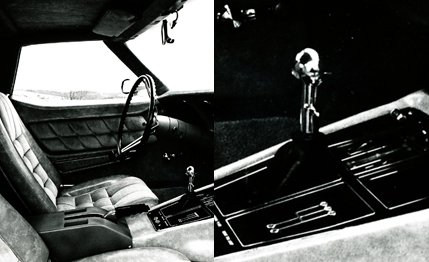The car shown here was built by Chuck Miller of Detroit. Miller’s usual work tends more toward the showcar circuit and its attendant spinoff into plastic model kits (for example his Zingers), but he restrained himself with this Vette, and the results are obvious.
The workmanship is fantastic—there is not a flaw, not a wrinkle, anywhere. He started by making a full-size plaster mockup, then a fiberglass model from which the roof was made. Every line seems to follow the natural evolution of the stock Corvette body lines, and even the windows all seem to fit with no contortions. Once the roof was on, Miller added super-large rear tires, necessitating the flared fenders, and the Thrush pipes and two-tone trick pearlescent paint were probably unavoidable additions to a custom car of this type. Miller also straightened out the bumper at the rear, and added a custom nose at the same time. Neither of these changes affects the function of the sportwagon roof at all, and leaving everything except the roof stock might make the car look even better—if you decide to build one.
|
|
| |
That’s right—build your own Stingray Sportwagon. Miller is going into limited production making mail-order kits with all the hardware necessary to convert Corvettes to wagons. The price is not yet firm—but it will be reasonable. Miller wants to sell a lot of them. (Available direct from Chuck Miller at Styline Custom, 13 Delisle Street, River Rouge, Michigan.) For the money, you get the roof piece, all the windows, an inner liner that covers what used to be the inside of your trunk, and a special gas tank which goes under the floor with its fittings. He is not supplying upholstery, since some people might prefer to go the full custom route, while the stock Corvette fabrics are easily available if you want to match the existing interior.
How does it work? Well, to be quite honest, unless you are a pretty accomplished body man, you had better plan on having someone else do the actual work—it requires a degree of proficiency that comes with more experience than just smoothing out parking dings with Bondo. A line must be cut down the crown of both fenders and across the back panel, just above the taillights. At this point, you are the proud owner of a backless Vette. Next, the rear floor is removed along with the gas tank. The tank is replaced by a flat one from a Ford Mustang, which instead of wrapping around the suspension like the stock tank, gets tucked in behind the axle. The fuel capacity drops from 20 gallons to 18 gallons, but the interior space increase more than makes up for the time you’ll lose getting gas 20 miles sooner than before. Everything fits under the floor and the filler pipe comes straight out the middle of the back between the taillights. (It isn’t there on this first car. Right now you have to add gas through a taillight.) The kit supplies all this hardware, including a quick-fill cap.
|
|
| |
Once the tank is in, the one-piece fiberglass liner which covers up the floor, the sides, and the back of the rear compartment is bolted in. It is contoured to leave the stock axle clearance and suspension travel. Nothing changes in that department. The stock battery box and lockable storage bins set in the floor behind the seats are also retained, as are most of the Vette’s other good features.
View Photos
View Photos


Leave a Reply